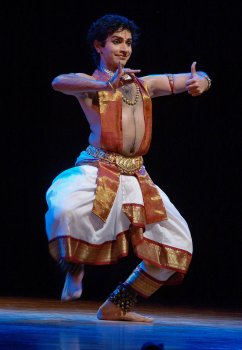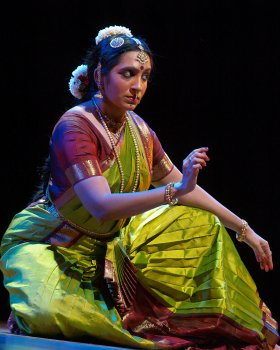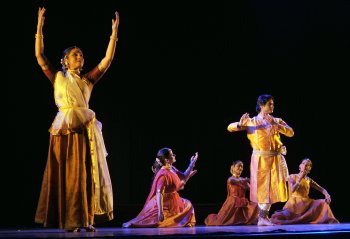
|   |

|   |
The Music Academy Dance Fest: Day 4 - Veejay Sai e-mail: vs.veejaysai@gmail.com Photos: Thanthoni January 12, 2012 The Thattuvangam act! The fourth day of the Academy’s dance festival opened with a solo Bharatanatyam dance recital by Mumbai-based male dancer Pavitra Bhat in the first slot. Pavitra started his show with a popular invocation to Lord Ganesha ‘Sri Vighnarajam Bhaje’ set to Nattai ragam, often performed by male dancers. Pavitra has a good stage presence and equally decent photogenic features a male dancer needs to have. Performing the famous swarajati ‘Rama Neeve’ set to Kharaharapriya ragam composed by Tenmatam Narasimhachari, Pavitra’s speedy jatis were totally unnecessary. His portrayal of the epic in a nutshell didn’t come through the way the varnam demanded it. Midway through the varnam his guru Deepak Mazumdar who was accompanying the orchestra with the nattuvangam stopped and everyone wondered what had happened. He decided to take the thattu and beat the sticks for the rest of the show! Pavitra has the promise of making it big as a soloist and with a little more integrity in his involvement, he could get rid of his image as a moving mannequin. He overshot his time provided in the slot, thanks to the unnecessarily elongated varnam, and hence had to cancel out the rest of the items he planned to perform, leaving the rest of his margam incomplete.  Pavitra Bhat  Uma Nambudripad Sathyanarayanan Vazhuvoor’s new waaris The second performance for the morning was a solo recital by Uma Nambudripad Sathyanarayanan, a senior disciple of Guru Chitra Visweswaran. Watching Uma’s dance, one was reminded of the older videos of her guru. The refinement and charm of the Vazhuvoor baani flowed eloquently in the choreography that her guru provided. Uma began with a Pravahanjali Ganga Kavuthuvam in raag Puriya Dhanashree, a composition of R. Visweswaran and Chitra Visweswaran. Uma’s graceful movements came forward in the solid jatis she danced to in the varnam ‘Nandanai Azhaitu Vaa’ set to Kambhodi ragam, a composition of Thiruveezhimizhalai Natarajasundaram Pillai. Watching Uma dance to the jatis composed by her guru Chitra, one could say Vazhuvoor’s baton has been successfully passed on to generation next. Seeing Uma’s polished dance, Lord Shanmukha couldn’t have asked the poignancy of a yearning nayika and a devout bhakta rolled in one and delivered so heart-rending and accurate. Uma continued to perform the famous dasaara pada ‘Jagadhodharana’ set to Kapi ragam. Once again Uma portrayed the role of mother Yashoda with high quality sophistication. With melodious vocals rendered by Murali Parthasarathy, Uma developed her sancharis with such tenderness and all one could see was little Krishna enjoying the love of his mother, recreated on stage to a fulfilling experience. Guru Vazhuvoor Ramaiah Pillai, whose centenary is being celebrated this year, would be delighted to see how his protégé Chitra Visweswaran carefully passed on the legacy of the baani to her student. With outstanding gurus like Chitra, the Vazhuvoor baani is all set to make an active come-back into every festival through all the many students she is mentoring. Golden girl of Sangam poetry  After an invocation titled ‘Prakriti - the scent of the earth,’ Valli strung together ancient, medieval and modern poetry in Sanskrit and Tamil exploring the kinetic, creative energy of the divine, embodied as nature, evoking the interdependence of all creation. Nature depicted in diverse moods and colours – spiritual and meditative, romantic and sensuous, awesome and terrible, life-sustaining and harmonious worked its presence through Valli’s natyam. The mellifluous music provided by Rajkumar Bharathi set the mood for the evening. Valli continued into a varnam in Shankarabharanam composed by her and Prema Ramamoorthy as her main item for the evening. Calling it a ‘celebration of the sacred and the sensual,’ the key-note of the varnam was passionate yearning and adoration that was interpreted on a dual layered narrative- the heroine of the song, depicted both as lover and devotee. The woman longing for her beloved is an analogy for divine love and the soul’s yearning for union with the Self, the love-symbolism, reinforced by the theme’s intertwining threads of the sensual and the spiritual. The third piece was a smart thematic amalgamation of more Sangam poetry from the songs of Kuruntogai in particular and a javali ‘Thelisevagalella’ in Bilahari ragam. Using the eloquent metaphors from ‘Karungkal Vembin’ or the crab song by Paranat, Valli depicted a woman's pain at her lover's desertion, her sense of complete isolation and anguish at finding herself the victim of vicious, spiteful gossip. This was powerfully evoked by the striking simile of seven ravenous crabs tearing to pieces and crushing a single fig, fallen by the riverside. The javali was a stark contrast to all pervading anguish of the previous poem. Valli announced earlier (an excellent quality of introducing new themes to newer audiences that has become her signature style over the decades) how she had woven these two together so that there was a progression in time and in the theme. In ‘Thelisevagalella,’ disillusioned by her lover's betrayal and infidelity, the nayika’s love, sours into bitterness and anger. She is unrelenting, wrathful and sarcastic at his attempts at reconciliation. Yet her pain comes forward well-pronounced. Valli concluded her performance with a ‘Swaralaya’ set to Vasantha ragam. With a selection from the intricate tapestry of the Purananooru anthology themed around patriotic fervor, Valli’s show ended with a thunderous applause. One couldn’t expect any lesser from the queen of Bharatanatyam at a festival of this stature. Nandini Anand Sharma’s vocals and Sruthi Sagar’s flute were noteworthy. Tempting tatkaar The evening ended with a group presentation by Parwati Dutta and members of Mahagami Gurukul from Aurangabad. While the first item they presented titled ‘Savaro Rang Bheeji’ was again broken into many fragmented pieces, it was difficult to string across any narrative to find any cohesiveness. However the second item they presented was titled ‘Srijan Teerth.’ Choreographing a dance journey and rediscovering various historical contexts and spaces where Kathak grew, Parwati and her team gave yet another interesting narrative into dance history in India. From the ‘Dhrupads’ by Miyan Tansen to Gopal Nayak’s courts in Aurangabad, from Raja Chhatrapati Singh’s fort in Bijna to Raja Chakradhar Singh’s compositions, from thumris by Bindadin Maharaj to padams by Swati Thirunal, the energetic dancers showed rasikas the various graphs of growth dance meandered through. Incidentally, Parwati Dutta is also an able research scholar in addition to being a performer. Her choreography spoke volumes of her scholarship. While the all-girl group presented its odds at catching the right ‘samm’ in places, it was refreshing to see intricate patterns being spun on stage by Sushant Jadhav (the only male dancer) whose tatkaar was remarkable to the choreography of each of the pieces.  Parwati’s dance was enhanced by the wonderful dhrupad music sung by Pandit Uday Bhawalkar, vocals and chants by Manoj Desai and Pakhawaj by Manik Munde. There were enough and more rasikas tapping their feet and swinging their arms as the taals and bols filled the air at the academy as it resounded with tatkaar. Veejay Sai is a writer, editor and a culture critic. |